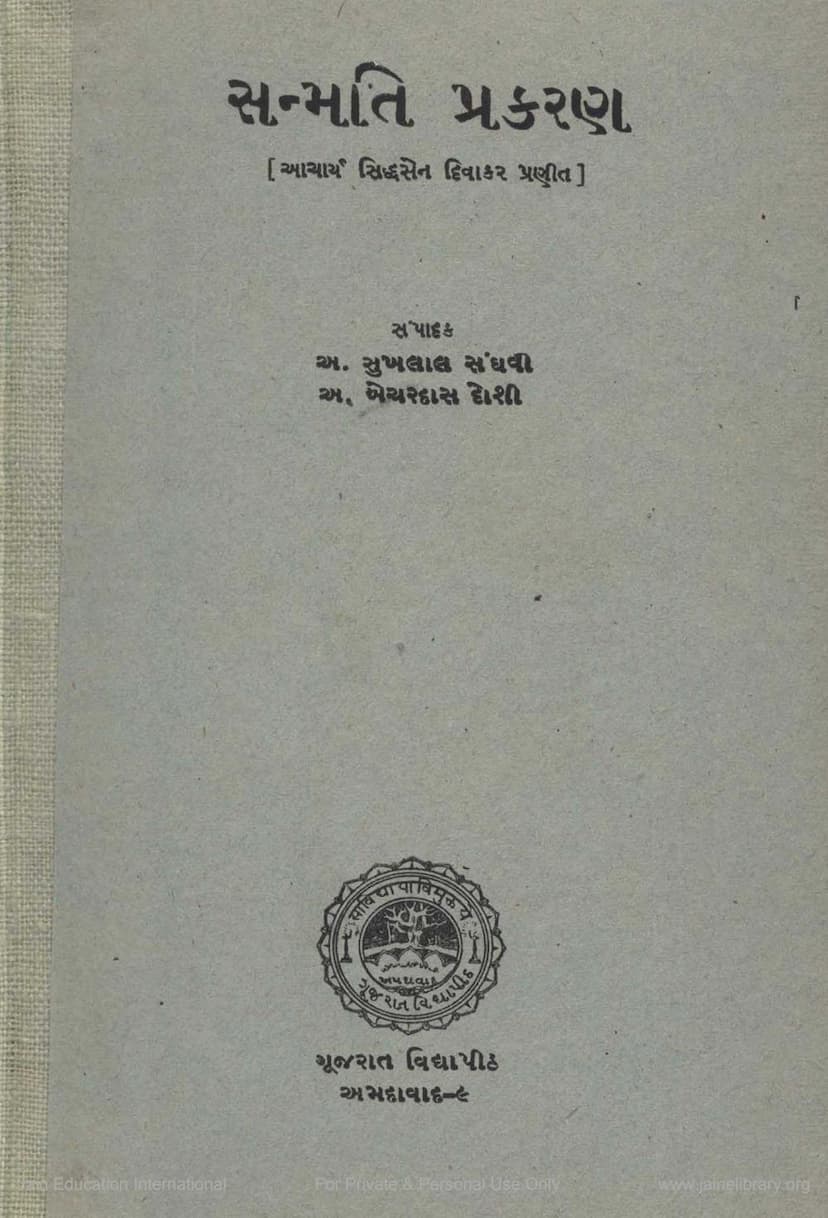Sanmati Tarka Prakaran
Added to library: September 2, 2025

Summary
This is a comprehensive summary of the Jain text "Sanmati Tarka Prakaran" by Acharya Siddhasen Divakar, as presented in the provided pages. The summary covers the introduction, author, commentator, textual analysis, and philosophical content of the work.
Book Title: Sanmati Tarka Prakaran Author: Acharya Siddhasen Divakar Editors/Translators: Pt. Sukhlal Sanghavi, Pt. Bechardas Doshi Publisher: Gujarat Vidyapith, Ahmedabad
Overall Summary:
"Sanmati Tarka Prakaran" (also referred to as Sanmati Tarka) is a foundational work in Jain logic and philosophy, authored by the esteemed Jain scholar Acharya Siddhasen Divakar. The text primarily aims to expound and establish the core Jain principle of Anekantavada (the doctrine of manifold aspects or non-absolutism) in a systematic and logical manner. It meticulously analyzes various philosophical viewpoints, refutes opposing arguments, and elucidates the nuances of Jain thought through rigorous debate and reasoned discourse. The book is highly regarded for its profound logical structure and its contribution to establishing the philosophical prestige of Anekantavada.
Key Aspects and Content:
-
Title Significance: The title "Sanmati" refers to Lord Mahavir, one of whose names it is. The text is named "Sanmati Prakaran" because it primarily deals with the principle of Anekantavada, which is considered the essence of Lord Mahavir's teachings.
-
Author and Commentary:
- Author: Acharya Siddhasen Divakar, a renowned Jain scholar who lived in the 4th-5th century CE. He is credited with presenting Anekantavada in a new, logical framework.
- Commentary: The text gained further depth and exposition through a commentary by Abhayadev, who lived in the 10th-11th century CE. His commentary, comprising approximately 25,000 verses, elaborates on various philosophical schools of thought prevalent up to his time, thoroughly discussing and refuting them from the Jain perspective. Gujarat Vidyapith published the original text with Abhayadev's commentary in five large volumes.
-
Core Objective: The primary goal of Siddhasen Divakar in composing this work was:
- To systematically present and analyze the principle of Anekantavada using logical reasoning.
- To establish its importance and prestige among logicians.
- To discuss other philosophical doctrines that follow from Anekantavada.
-
Structure and Content:
- The original text is composed in Prakrit language, consisting of approximately 166 Arya verses.
- The summary provided (pages 12-16) outlines the detailed structure, divided into sections covering:
- Introduction to Manuscripts (Prati): Discusses ancient writing materials (palm leaves, birch bark, paper), script types, manuscript classification, scribal errors, corrections, and the editorial methodology used.
- Introduction to the Author (Mulkar): Delves into Siddhasen Divakar's time, life, his interactions with other contemporary philosophers (Jain and non-Jain), and his significant contributions.
- Introduction to the Commentator (Tika-kar): Provides information about Abhayadev, his lineage, and his extensive commentary.
- Introduction to the Original Text and Commentary: Details the nomenclature, language, style, size, and divisions of the "Sanmati Tarka." It extensively discusses "Anekantavada" – its definition, historical development, and comparison with other Indian philosophies.
- Introduction to the Thirty-two Treatises (Batriśi): Briefly touches upon the thirty-two smaller works attributed to Siddhasen, categorized as eulogistic, critical, and philosophical.
- Translation of Sanmati Prakaran: This section presents the detailed content of the text, broken down into three "Kandas" (sections):
- First Kanda (Pratham Kand): Focuses on the praise of the Jain teaching through the description of its extraordinary qualities, the author's pledge to compose the work, and the introduction to the main subject matter – the Nayas (means of acquiring knowledge). It details Dravastika Naya and Paryayastika Naya, their subdivisions, their relation to different speech types, and the concept of non-contradiction. It introduces Naya (means of knowledge) and Niskhep (classification) and explains how different perspectives (Nayas) lead to varied understandings of reality.
- Second Kanda (Dwitiya Kand): Primarily deals with the distinction and relationship between Darshan (perception/intuition) and Gyan (knowledge). It analyzes how these are understood in Jainism, contrasting them with other philosophical schools, particularly regarding sequential vs. simultaneous apprehension and the nature of knowledge and perception, especially in the context of Kevala Gyan (omniscience).
- Third Kanda (Tritiya Kand): Continues the logical discourse, further analyzing concepts like general vs. particular, the nature of cause and effect, the interdependence of different views (Nayas), and the critique of absolutist viewpoints (Ekantha). It highlights the comprehensiveness and systematic approach of Anekantavada, discussing how different aspects of reality are integrated. It also touches upon the nature of soul, karma, liberation, and the refutation of various philosophical schools that deviate from the Jain path.
-
Central Theme - Anekantavada: The book is a profound exploration of Anekantavada. It explains that reality is multifaceted and can be viewed from multiple perspectives (Nayas). It argues that clinging to any single viewpoint (Ekantha) leads to partial and ultimately incorrect understanding. The text emphasizes that true knowledge (Samyak Gyan) arises from understanding these multiple perspectives and their synthesis, leading to Samyak Darshan (right perception) and ultimately Samyak Charitra (right conduct) and Moksha (liberation).
-
Logical Structure: The work is highly praised for its rigorous logical structure, employing dialectical methods to establish Jain principles and refute opposing views. The commentary by Abhayadev further enhances this logical rigor.
-
Influence: The text significantly influenced later Jain philosophical discourse, contributing to the systematic development of Jain logic. Its approach to synthesizing different viewpoints and establishing the supremacy of the Anekantavada perspective through reasoned argument made it a cornerstone of Jain intellectual tradition.
-
Manuscript and Publication: The summary details the effort in collecting and comparing various manuscripts for the publication, highlighting the challenges and the importance of textual accuracy in such scholarly endeavors. The publication by Gujarat Vidyapith is presented as a significant contribution to making this ancient text accessible.
This summary captures the essence of the provided text, highlighting its author, purpose, key philosophical concepts like Anekantavada and Naya, its structure, and its historical significance within Jainism.